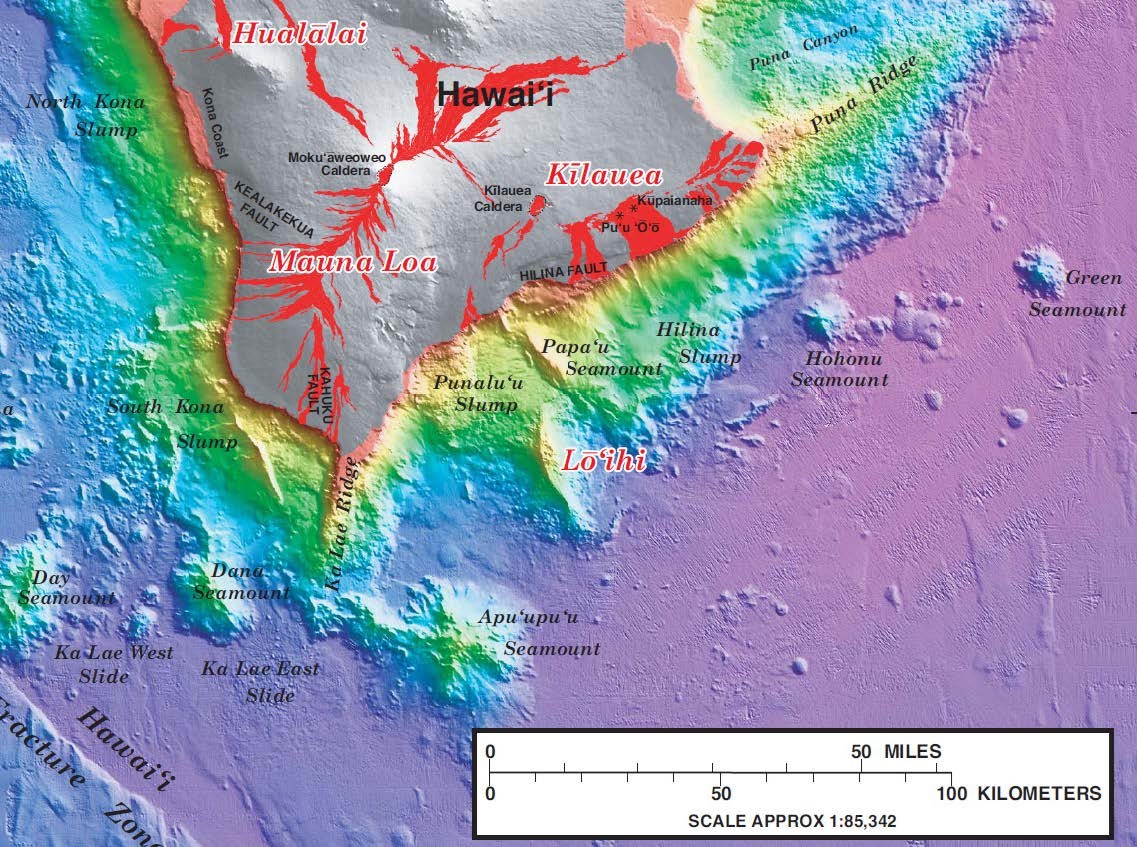Last updated: April 14, 2023
Article
Volcanic Processes—Landslides


Left image
Crater Lake National Park, Oregon. View southwest of Garfield Peak and Eagle Crags above Chaski Bay. Talus rests on top of massive slide block. The block was displaced downward from high on the caldera wall.
Credit: USGS photo.
Right image
Photo with feature labels.
Credit: USGS photo.
Introduction
All volcanic edifices are susceptible to landslides, and landslides are important processes on composite and shield volcanoes.
Some mass wasting events, particularly debris avalanches, occur during or soon after volcanic eruptions. Landslides may also occur at other times.
Mass wasting events are particularly prevalent on composite volcanoes because these volcanoes are steep and have weakened areas due to the presence of clay minerals where hydrothermal alteration has taken place. Most composite volcanoes also have high volumes of fractured rock or loosely consolidated pyroclastic deposits.
Shield volcanoes are also subject to mass wasting, and large landslides or slumps are a part of the life cycle of Hawaiian shield volcanoes like Haleakalā in Haleakalā National Park, and Mauna Loa and Kīlauea in Hawai‘i Volcanoes National Park.
Basalt is susceptible to weathering and erosion, particularly in Hawai‘i’s wet tropical climate. Shield volcanoes also undergo hydrothermal alteration. Subaqueous eruptions produce tephra and fractured rock which are also more easily eroded.
Debris Avalanches
Debris avalanches are a type of fast-moving landslide that occurs when a sector of a volcanic edifice collapses. Debris avalanches may transition into lahars in the presence of adequate water. Debris avalanches may leave horseshoe-shaped craters such as at Mount St Helens.
Lassen Volcanic National Park
Chaos Jumbles is a debris-avalanche deposit formed by the partial collapse of one of the domes in Chaos Crags. Chaos Crags is a set of six domes that were emplaced about 1,050 years ago. The Chaos Jumbles debris-avalanches took place in approximately 1670 CE and were probably caused by slope instability and do not appear to be caused by a volcanic eruption.

Chaos Crags and Chaos Jumbles. Chaos Jumbles—a huge avalanche-debris deposit (map unit Hsj)—formed as a result of partial collapse of dome C of Chaos Crags (Hrcc). The collapse was catastrophic, and three debris avalanches were emplaced in quick succession. Material from the avalanche deposits created Chaos Jumbles, which is in the foreground of the photograph.
NPS photo.
Crater Lake National Park
Landslides and other slope movements have enlarged the Crater lake caldera after it collapsed in the mega-colossal eruption. In fact, landslides are responsible for almost half the width of the Crater Lake depression. Landslides are responsible for Crater Lake’s distinctive scalloped caldera walls.


Left image
The Chaski Slide took place about 200 years after the caldera-forming eruption. It is the largest of these caldera-widening debris avalanches. Debris from the Chaski Slide is visible in the bathymetry map of the caldera floor underneath the lake.
Credit: USGS photo.
Right image
Image with feature labels.
Credit: USGS photo.
Hawaiʻi Volcanoes National Park
Mass movements on the shield volcanoes in Hawaiʻi Volcanoes National Park are important processes that continue to shape these landscapes.

Related Links
-
Crater Lake National Park (CRLA), Oregon—[CRLA Geodiversity Atlas] [CRLA Park Home] [CRLA npshistory.com]
-
Hawaiʻi Volcanoes National Park (HAVO), Hawaii—[HAVO Geodiversity Atlas] [HAVO Park Home] [HAVO npshistory.com]
-
Lassen Volcanic National Park (LAVO), California—[LAVO Geodiversity Atlas] [LAVO Park Home] [LAVO npshistory.com]
